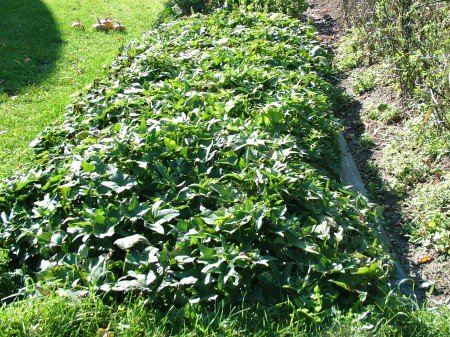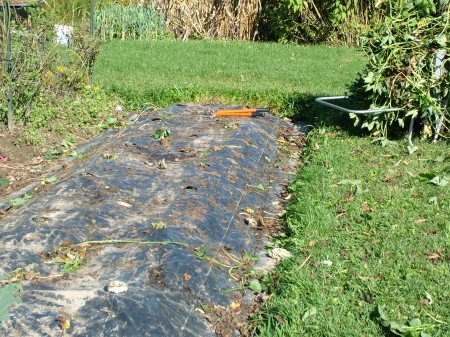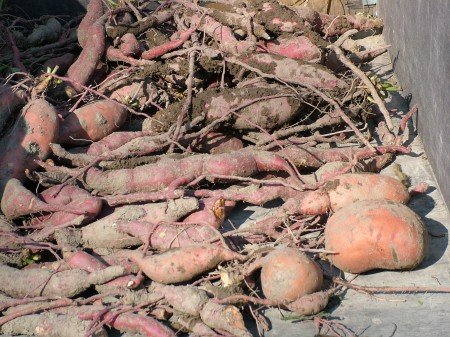With several nights of frost predicted for this coming week, it was time to harvest the sweet potatoes. They will not tolerate frost. Here’s the bed of potatoes, thick with foliage. The plants are grown through a cover of black plastic which heats the bed up quickly in the spring and pretty much eliminates any weeds.
Harvesting is much easier if all the foliage is cut away and removed first. This is the second year I used this sheet of plastic and it looks like it will be in good enough shape to use one more time. I’m not a fan of using polyethylene, but I bought a roll of the material years ago and I get multiple uses out of each sheet which assuages my guilt, slightly. We are researching other more ecologically benign fabrics for future use.
Sweet potatoes are very delicate when they are first dug. They snap easily and it’s hard to keep from stabbing them with your digging tools. This year’s harvest set no records for weight or size. I attribute that to the particularly clayey nature of this bed. The softer the soil the better. I took a chance and so I can only blame myself for a less than spectacular yield. The plants were very healthy, but the tubers did not fill out as well as most of my previous harvests. A lesson learned. I’ll work a lot more compost into next year’s bed.
Nevertheless, we’ll still have lots of sweet potatoes to store. We let the tubers air dry in the kitchen for two weeks, then we wrap them in newspaper and store them in the basement. It’s important to use up the smaller and stringy tubers first, as they do not store well. Larger tubers, however, can last up to a year in storage.




as I understand it from my local Extension agent, sweet potatoes like lousy soil. When I improved my bed with compost, etc (all organically of course), I got stringy sweet potatoes. When I ignored them except for watering when it was really dry, they were good. The agent pointed out they’re a storage tuber so too much food encourages leaf growth and discourages storing food for next year
Susan. You may be right about the soil fertility part, but I was thinking more about how hard the clay was and whether that was an impediment to big tuber growth. A friend of mine who lives close by grew his sweet potatoes this year in a super soft bed of almost pure leaf compost and got some incredibly huge tubers and excellent weight per plant. I’ll have to do some research, but I think soil softness helps.
We just harvested our first time ever crop of sweet potatoes. We only had 4 slips but got about 10 lbs of really beautiful potatoes. We had read that loose soil was really important to allow the tubers to fill out and had made the bed with lots of mulch that we get free from the city’s street department. It is really rough stuff with lots of twigs, etc. But it made our clay soil very loose. We did not fertilize and watered rarely during our historic drought.
Hubby was so surprised when he turned his potato fork over and saw the beautiful plump tubers come to the top. Since our regular potatoes were hardly enough to put in a pot of green beans, he wasn’t expecting much of a harvest of sweet potatoes.
Irene. I’m a believer. Next year, lots of soft material into the sweet potato bed.